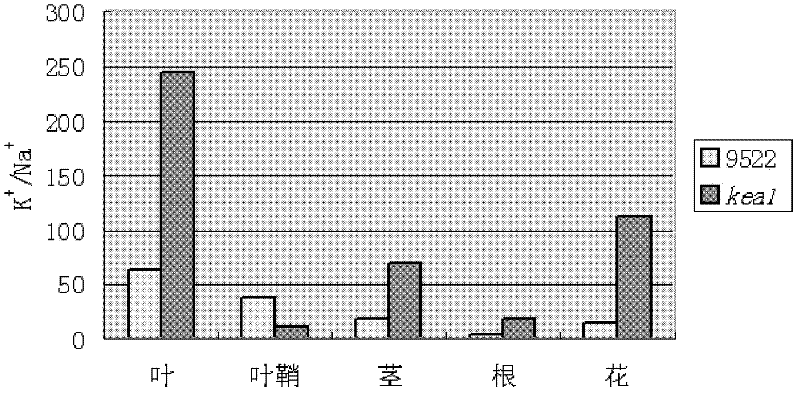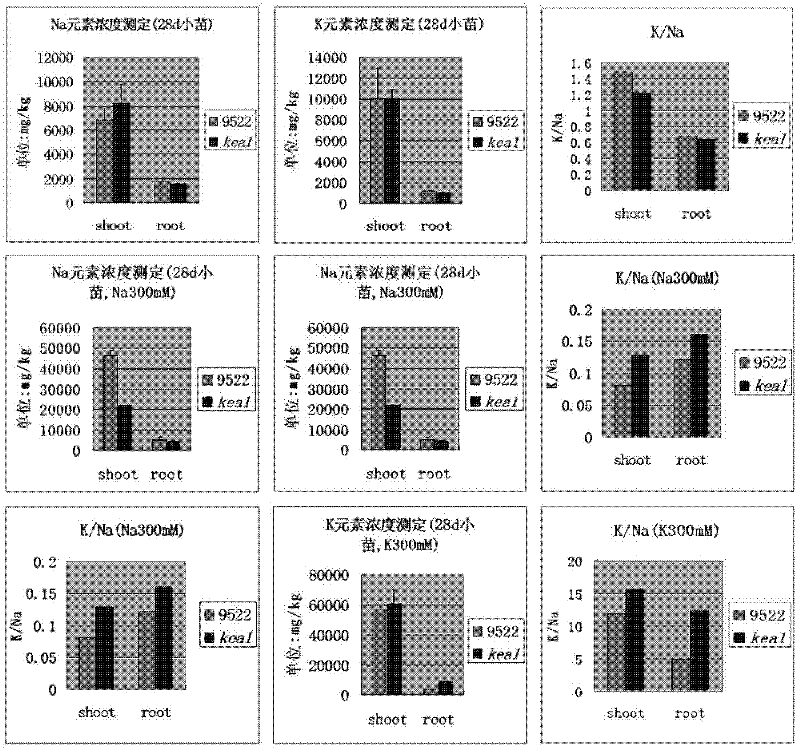Method for improving rice potassium ion efflux antiporter
A technology of antiporter protein and potassium ions, which is applied in the field of improving rice potassium ion efflux and reverse transport, and can solve problems such as yield reduction and photosynthetic efficiency reduction
- Summary
- Abstract
- Description
- Claims
- Application Information
AI Technical Summary
Problems solved by technology
Method used
Image
Examples
Embodiment 1
[0028] Embodiment 1: Obtaining and morphological observation of kea1 mutant plants
[0029] This mutant was used in our laboratory 60 Japonica rice 9522 seeds were induced by Coγ-rays at a dose of 280Gy. Backcrossing a midrib adaxial-specific whitening mutant in the F2 generation of mutagenesis for three generations obtained a recessive single-gene regulated stably inherited mutant kea1. All plant materials were planted at the experimental base of Shanghai Academy of Agricultural Sciences.
[0030] Morphological observation of kea1 mutant plants. Such as figure 1 , The phenotype comparison between wild type and mutant kea1 shows that the leaf color of wild type 9522 is normal (left) (A, B, C), while the leaves of kea1 mutant are specifically whitened on the adaxial surface of the midrib (right) (A, B, C); the number of chloroplasts on the adaxial surface of the midrib of the wild-type leaves is large, and the arrangement is regular (top) (D); the number of chloroplasts on ...
Embodiment 2
[0031] Example 2: Kea1 mutant and wild-type 9522 ion concentration determination
[0032] (1) Processing of samples. The roots, stems, leaves, leaf sheaths and flowers of the reproductive growth period ( Figure 2A ), and the aerial parts and roots of the 28d seedlings under the conditions of normal growth and salt treatment (treated with NaCl 300mM and KCl 300mM respectively for 3d) ( Figure 2B ), first in 5mM CaCl 2 The solution was quickly washed twice in pure water, once in double distilled water, and three times in ultrapure water. Oven at 90°C until constant weight.
[0033] (2) Determination of potassium and sodium ion concentrations in rice. After the material is baked, weigh it with an electronic balance, then put it into a 50ml centrifuge tube, add 0.1M acetic acid solution, put it in a water bath at 90°C for 3 hours, and mix it upside down for 5-6 times in the water bath. Pour the extract into a 2ml centrifuge tube, centrifuge at 12,000rpm for 5-10min, take th...
Embodiment 3
[0034] Example 3: Location and cloning of the KEA1 gene
[0035] (1) Positioning groups. Kea1 was crossed with the indica rice line Guangluai 4, and the F2 generation was obtained by selfing. Among them, the plants with adaxial-specific whitening of the midrib of the leaves were selected as the positioning population.
[0036](2) Rice DNA extraction. Using the improved CTAB method. The simple steps are as follows: Take 0.1-0.2 grams (about half a piece) of leaves and put them in a small mortar, add an appropriate amount of liquid nitrogen, grind them to powder immediately, put them into a 2ml centrifuge tube, add 700ul of 1.5xCTAB solution preheated at 100℃ in In a centrifuge tube, mix carefully and place in a 56°C water bath. Take out the centrifuge tube after 20 minutes, add an equal volume of chloroform / isoamyl alcohol, mix vigorously, centrifuge (13000rpm) for 10 minutes, take the supernatant into a new tube, add Mix 900ul of absolute ethanol and place at -20°C for more...
PUM
 Login to View More
Login to View More Abstract
Description
Claims
Application Information
 Login to View More
Login to View More - R&D
- Intellectual Property
- Life Sciences
- Materials
- Tech Scout
- Unparalleled Data Quality
- Higher Quality Content
- 60% Fewer Hallucinations
Browse by: Latest US Patents, China's latest patents, Technical Efficacy Thesaurus, Application Domain, Technology Topic, Popular Technical Reports.
© 2025 PatSnap. All rights reserved.Legal|Privacy policy|Modern Slavery Act Transparency Statement|Sitemap|About US| Contact US: help@patsnap.com



